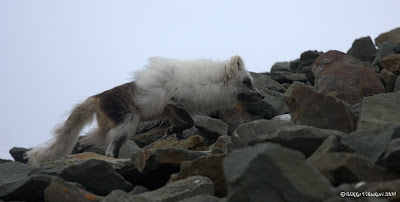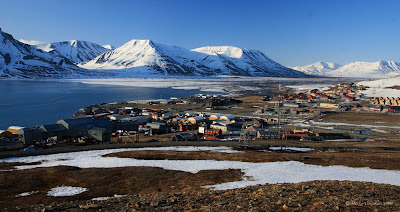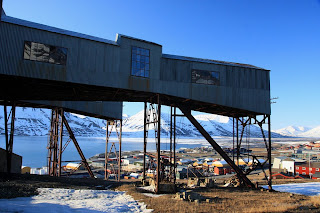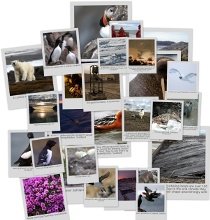Monday, June 22, 2009
Sunday, June 21, 2009
Photo of the Day - Grey Phalarope
 A lively wader, grey phalarope, has got its name, because its grey in UK while on the way to the wintering grounds somewhere in the far south. The american name red phalarope tells more about its appearance in the breeding grounds in the Arctic. For us its red, indeed.
A lively wader, grey phalarope, has got its name, because its grey in UK while on the way to the wintering grounds somewhere in the far south. The american name red phalarope tells more about its appearance in the breeding grounds in the Arctic. For us its red, indeed.
Saturday, June 20, 2009
Friday, June 19, 2009
Thursday, June 18, 2009
Tuesday, June 16, 2009
Skansbukta
 A great thing with this job as a field assistant is that you have to be out almost every day. About week a go we went for an overnight camping trip to Skansbukta, a bay that is located about 17 nm inwards Isfjorden from Longyearbyen. The name (engl. redoupt bay) it has got from a mountain Skansen which looks little bit like a castle. Skansen is well-known from it's bird colonies, which we were cheking out, and Skansbukta from the old plaster mine located there.
A great thing with this job as a field assistant is that you have to be out almost every day. About week a go we went for an overnight camping trip to Skansbukta, a bay that is located about 17 nm inwards Isfjorden from Longyearbyen. The name (engl. redoupt bay) it has got from a mountain Skansen which looks little bit like a castle. Skansen is well-known from it's bird colonies, which we were cheking out, and Skansbukta from the old plaster mine located there.
Monday, June 15, 2009
Photo of the Day - Balance of Terror
 Producing offspring is serious stuff. For many birds on Svalbard breeding is fighting for space with others, trying to avoid predators and keeping eggs warm to ensure developing embryo. Tension. It can not be avoided.
Producing offspring is serious stuff. For many birds on Svalbard breeding is fighting for space with others, trying to avoid predators and keeping eggs warm to ensure developing embryo. Tension. It can not be avoided.
Friday, June 12, 2009
Photo of the Day - Little Auks
 Little auk is a small social auk species breeding under stones on steep slopes in the Arctic. It is probably the most numerous seabird species in the world, breeding in huge quantities on Svalbard. Little auk colonies are found almost everywhere. Their squeaky sounds are the sound of summer for many Svalbardians.
Little auk is a small social auk species breeding under stones on steep slopes in the Arctic. It is probably the most numerous seabird species in the world, breeding in huge quantities on Svalbard. Little auk colonies are found almost everywhere. Their squeaky sounds are the sound of summer for many Svalbardians.
As a black and white swift small birds they are difficult to photograph. One would think that a bright sunny day would produce good light for photography, but this apparently is not the case. Maybe the best yellow light could be achieved on cloudless nights? One of my this years projects is to produce sufficient photos of these extremely attractive and lively birds...
Thursday, June 11, 2009
Photo of the Day - Arctic Fox
 Arctic foxes are considered as endangered in mainland Scandinavia, but are doing strong on Europe's northernmost archipelago. Being entirely white in the winter and brown during the summers, their camouflage is good enough to sneak attack on adult birds, such as auks, guillemots and geese. They are beautiful animals, always except during the moulding season, which is happens in June. Summer offers fox days for the foxes. Newly hatched bird chicks and eggs are so plentiful, that it's no need to sneak on adult birds. Killed chicks and found eggs are stored between rocks for later use in the winter. Busy, sneaky foxes are almost everyday sights on bird colonies.
Arctic foxes are considered as endangered in mainland Scandinavia, but are doing strong on Europe's northernmost archipelago. Being entirely white in the winter and brown during the summers, their camouflage is good enough to sneak attack on adult birds, such as auks, guillemots and geese. They are beautiful animals, always except during the moulding season, which is happens in June. Summer offers fox days for the foxes. Newly hatched bird chicks and eggs are so plentiful, that it's no need to sneak on adult birds. Killed chicks and found eggs are stored between rocks for later use in the winter. Busy, sneaky foxes are almost everyday sights on bird colonies.
Wednesday, June 10, 2009
Photo of the Day - the Brent Geese
 Brent goose is a relatively shy and not very common goose species on Svalbard. In addition to king eiders, also the brent geese are less regularly seen around Longyearbyen later in the season. On typical years there has been some brent goose observations in Adventvalley, but for nesting they seem to disappear into the numerous remote valleys and islands around the archipelago. This year we spotted a record breaking flock (at least for me) in the valley. 80 individuals were grazing on the first green plants and getting fit for the long and exhausiting nesting period. A day later they all were gone and probably won't come back until the next spring. Snow is melting rapidly. The nesting has begun!
Brent goose is a relatively shy and not very common goose species on Svalbard. In addition to king eiders, also the brent geese are less regularly seen around Longyearbyen later in the season. On typical years there has been some brent goose observations in Adventvalley, but for nesting they seem to disappear into the numerous remote valleys and islands around the archipelago. This year we spotted a record breaking flock (at least for me) in the valley. 80 individuals were grazing on the first green plants and getting fit for the long and exhausiting nesting period. A day later they all were gone and probably won't come back until the next spring. Snow is melting rapidly. The nesting has begun!
Tuesday, June 9, 2009
Photo of the Day - Cocks of the Dogyard
 At a first glance, it appears that eiders are nesting in strange places. One example: at least 50 pairs that are nesting right next to the main dogyard in Longyearbyen. A busy place, where dogs are barking constantly and peace from people is just a remote fantasy. Eider males are making sure that their females are not having fun with other guys. They'll patrol next to the nesting females until their chicks have hatched, howling to the sky and attacking any other male, who dares to enter their territory. When the chicks are hatching the cocks take of in groups and go feeding on scallops in the sea for the rest of the summer. The females can take care of the offspring.
At a first glance, it appears that eiders are nesting in strange places. One example: at least 50 pairs that are nesting right next to the main dogyard in Longyearbyen. A busy place, where dogs are barking constantly and peace from people is just a remote fantasy. Eider males are making sure that their females are not having fun with other guys. They'll patrol next to the nesting females until their chicks have hatched, howling to the sky and attacking any other male, who dares to enter their territory. When the chicks are hatching the cocks take of in groups and go feeding on scallops in the sea for the rest of the summer. The females can take care of the offspring.
And why are they nesting in such a place? There is a good reason. The arctic foxes are afraid of dogs and won't dare to come even close to the place. Those few nests taken by accidentally unleashed dogs are a small harm compared to that destruction one fox could do.
Monday, June 8, 2009
Photo of the Day - Isfjorden
 Longyearbyen, the "capital of Svalbard" is located on the coast of Isfjorden, one of the major fjord systems on Svalbard. Being based to Longyearbyen Isfjorden is naturally our working ground. Not the most exotic place compared to other places around the archipelago, but when the weather is nice, the field work can be quite a pleasure. This photo is from Diabas, close to our Brünnich's guillemot research colony.
Longyearbyen, the "capital of Svalbard" is located on the coast of Isfjorden, one of the major fjord systems on Svalbard. Being based to Longyearbyen Isfjorden is naturally our working ground. Not the most exotic place compared to other places around the archipelago, but when the weather is nice, the field work can be quite a pleasure. This photo is from Diabas, close to our Brünnich's guillemot research colony.
Sunday, June 7, 2009
Flashback! - Wildlife of South East Asia
Here is a collection of the wildlife shots I took during my trip to South East Asia earlier this year. The page needs Flashplayer to work. If you want to shuffle the photos, you can access the album by clicking the Google symbol on the right down corner or by clicking this link (works also for those without Flashplayer).
Saturday, June 6, 2009
Photo of the Day - King Eider
 King eider male is a magnificent bird with it's colourful forehead. The king eider is a species that utilizes fresh-water ponds as breeding grounds. Early in the season the birds are assembling to the marches in Advendalen (the valley next to Longyearbyen) to find a partner while waiting for the inland bonds to melt. From here they eventually will head to the inland where spotting them is often difficult. This gives the feeling that the species rarer than it actually is.
King eider male is a magnificent bird with it's colourful forehead. The king eider is a species that utilizes fresh-water ponds as breeding grounds. Early in the season the birds are assembling to the marches in Advendalen (the valley next to Longyearbyen) to find a partner while waiting for the inland bonds to melt. From here they eventually will head to the inland where spotting them is often difficult. This gives the feeling that the species rarer than it actually is.
There was lots of snow this winter. Melting has taken longer than on average. Probably that's why there are much more king eiders around Longyearbyen than before. A flock of hundreds individuals is currently floating around in the bay close to River Adventelva delta!
Friday, June 5, 2009
Photo of the Day - Spring Awakening
 Spring is a good time for a wannabe nature photographer. Nature awakes from the long hibernation. Birds are back "doing stuff" in the pursuit of making new life, being much more active than later in the season.
Spring is a good time for a wannabe nature photographer. Nature awakes from the long hibernation. Birds are back "doing stuff" in the pursuit of making new life, being much more active than later in the season.
On Svalbard the spring starts already sometime in the late April, but the real action takes place in the beginning of June when snow disappears from the breeding grounds. Taking photographs from displaying animals, such as these common eiders, is rewarding. It gives a possibility to observe the courtship and fetches an incredible amount of joy inside the photographer. The courtship season lasts only some weeks. After that a passive incubating takes place leading to the time, when new life spawns all-over the archipelago. The season is short, the development mind-blowingly fast.
From here it starts. May my camera rest after the season.
Thursday, June 4, 2009
Photo of the Day - An Other Day in the Office
 Little auk is a small auk species that nests under rocks on mountain slopes in the Arctic areas. It is one of the most extensively studied species at Norwegian Polar Institute. Our research colony is located to a slope in Bjørndalen. Because of the intensive study, Bjørndalen feels sometimes like another office for us. The way up there is pretty steep, but how many really has a better view from their office? Probably even the leader of Petronas would be jealous - and even better it's goes for a good exersise to climb up almost every day!
Little auk is a small auk species that nests under rocks on mountain slopes in the Arctic areas. It is one of the most extensively studied species at Norwegian Polar Institute. Our research colony is located to a slope in Bjørndalen. Because of the intensive study, Bjørndalen feels sometimes like another office for us. The way up there is pretty steep, but how many really has a better view from their office? Probably even the leader of Petronas would be jealous - and even better it's goes for a good exersise to climb up almost every day!
Tuesday, June 2, 2009
Svalbard
 Longyearbyen at mid-night
Longyearbyen at mid-night
Svalbard is an archipelago located between 76 and 80.5 degrees North, half way from the North Pole to mainland Norway. There is an university there. UNIS is an institute, which tends to change lives. It gives young people reason to live in and like cold places. It is the place where I learned great deal of skills I need in my work today. If you have been studying at UNIS for longer time, you'll get stamped as an "old UNIS student". That stamp follows you the rest of your life. Odd in it's own way, gray, cloudy, cold, snowy and sometimes slightly windy, but still warmer than any place in world. The arrival to Svalbard is like so many times before. Strangely it feels like I never left. That's how the old UNIS students do. Wander around, but always end up to the island time after time. Svalbard has it's own rules, but it's like cycling: once you have learnt it, it just feels natural.
Odd in it's own way, gray, cloudy, cold, snowy and sometimes slightly windy, but still warmer than any place in world. The arrival to Svalbard is like so many times before. Strangely it feels like I never left. That's how the old UNIS students do. Wander around, but always end up to the island time after time. Svalbard has it's own rules, but it's like cycling: once you have learnt it, it just feels natural. This time, to my surprise, two of my good friends, Allison and Daniel, were waiting at the airport. I guess I happened to mention that I am coming, but didn't ask anyone to pick me up. We were supposed to have an own transport organised by the Polar Institute. A gesture is highly appreciated, though. It makes the feeling of coming back home.
This time, to my surprise, two of my good friends, Allison and Daniel, were waiting at the airport. I guess I happened to mention that I am coming, but didn't ask anyone to pick me up. We were supposed to have an own transport organised by the Polar Institute. A gesture is highly appreciated, though. It makes the feeling of coming back home. When we drive towards Forskningsparken, where UNIS and Norwegian Polar Institute are located, I watch the snow covered mountains. There are still quite many snow patches around the town, which is normal for early June. Eiders are floating around in the bay. The geese are grazing on moss. I see some kittiwakes flying by. There is also one huge glaucous gull, which seems to be very focused on pecking a junk of garbage, which it probably has taken from a rubbish bin. At the evening the sky opens. Sun shines to the town without changing colour even at mid-night. There is no place like Svalbard. It feels like home.
When we drive towards Forskningsparken, where UNIS and Norwegian Polar Institute are located, I watch the snow covered mountains. There are still quite many snow patches around the town, which is normal for early June. Eiders are floating around in the bay. The geese are grazing on moss. I see some kittiwakes flying by. There is also one huge glaucous gull, which seems to be very focused on pecking a junk of garbage, which it probably has taken from a rubbish bin. At the evening the sky opens. Sun shines to the town without changing colour even at mid-night. There is no place like Svalbard. It feels like home.











